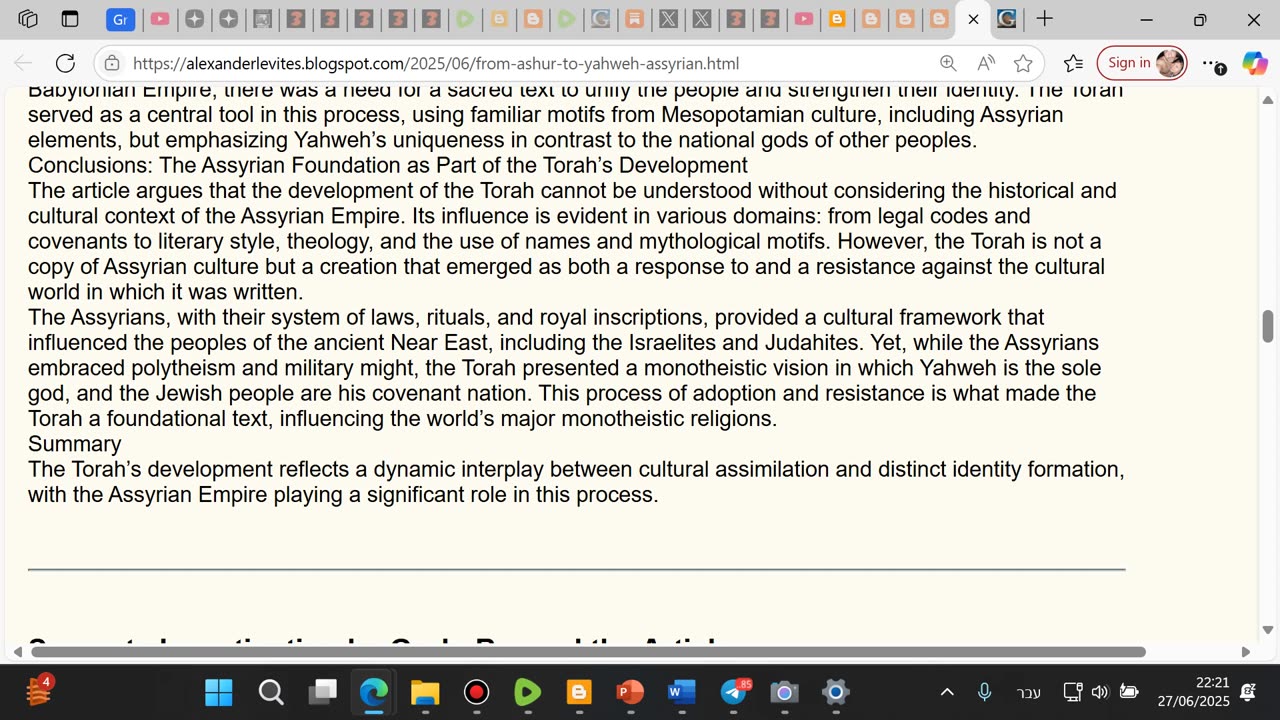Premium Only Content

"From Ashur to Yahweh: The Assyrian Foundation of the Torah"
https://alexanderlevites.blogspot.com/2025/06/from-ashur-to-yahweh-assyrian.html
Part 1: Introduction and Historical Context
From Ashur to Yahweh: The Assyrian Foundation of the Torah
The Torah, also known as the Pentateuch of Moses, is the foundation of Judaism, Christianity, and Islam. However, its origins and development remain a subject of scholarly debate. One lesser-known but significant hypothesis is that the Assyrian Empire, one of the great powers of the ancient Near East, played a key role in shaping the Torah. This influence is evident in both the religious and legal content of the texts and the theological ideas that crystallized during the period of Assyrian dominance in the Middle East.
Historical Background
In the 8th and 7th centuries BCE, the Assyrian Empire controlled vast territories, from Mesopotamia to Egypt. In 722 BCE, after a prolonged siege, the Assyrians conquered the northern Kingdom of Israel, destroyed its capital Samaria, and exiled much of its population. These exiles, known as the "Ten Lost Tribes," were assimilated into other societies under Assyrian rule. The southern Kingdom of Judah, by contrast, survived as a vassal state under the Assyrians but was forced to contend with their cultural and religious influence.
The Assyrians were not content with military conquest alone. They assimilated conquered peoples through policies of exile, population mixing, and heavy taxation. Simultaneously, they promoted their own culture and religion, including the worship of the national god Ashur (Assur), which symbolized the empire’s supremacy. This policy influenced the region’s peoples, including the Israelites and Judahites, who lived in the shadow of the empire.
Religious and Cultural Influence
Many scholars point to similarities between Assyrian culture and the Torah. For example, the concept of a covenant between a god and a people, central to the Torah, also appears in Assyrian texts. Treaties between the Assyrian king and vassal peoples included oaths of loyalty and laws, similar to the covenant between Yahweh and the people of Israel. Likewise, the legal codes in the Torah, such as those in Deuteronomy, resemble in structure the Code of Hammurabi and Assyrian laws, which established punishments and social regulations.
Part 2: Theological and Literary Parallels
Religious and Cultural Influence (Continued)
The similarity between the Torah and Assyrian culture extends beyond legal codes. At the theological level, influences can also be identified. The god Ashur, the Assyrians’ national deity, was described as ruling over the entire world and demanding absolute loyalty from his people. This conception resembles how Yahweh is portrayed in the Torah as a supreme god who demands exclusive worship and prohibits idolatry. Scholars argue that the shift toward pronounced monotheism in Judaism, which solidified during this period, may have been a response to Assyrian culture, where the national god held a central place.
Additionally, Assyrian texts, such as royal inscriptions and religious documents, emphasize the king’s role as the god’s representative on earth. This idea appears in the Torah, where the Israelite king is seen as acting in Yahweh’s name. For instance, in Deuteronomy (Chapter 17), the laws of kingship stipulate that the king must obey the Torah and avoid behavior contrary to God’s will. These laws reflect the Assyrian tradition, where the king was required to uphold divine laws to secure the god’s blessing.
Influence on the Torah’s Composition
A central claim among scholars is that parts of the Torah, particularly Deuteronomy, were written or edited during the period of Assyrian influence over Judah, namely in the late 7th century BCE. This era was marked by political and religious crises, including the religious reforms under King Josiah (640–609 BCE). According to the Bible (2 Kings 22–23), a "Book of the Torah" was discovered during temple renovations, serving as the basis for a reform that included purging foreign cults and centralizing worship in Jerusalem.
Modern scholars believe this "Book of the Torah" was likely an early version of Deuteronomy. This book contains laws and theological ideas with parallels in Assyrian culture, such as an emphasis on loyalty to one god and a covenant between the deity and the people. For example, Assyrian vassal treaties included clauses similar to the covenant structure in Deuteronomy, such as promises of blessings for obedience and curses for violation.
Names and Mythology
Another Assyrian influence is evident in names and mythology. The name "Ashur" (Assur), the Assyrians’ national god, may be linked to certain biblical names. For instance, scholars have noted a possible similarity between "Ashur" and "Asher," one of the tribes of Israel. While the connection is not definitive, it suggests cultural exchange between the peoples.
Moreover, mythological stories in the Torah, such as the Flood narrative (Genesis 6–9), show similarities to Mesopotamian myths like the Epic of Gilgamesh, which were prevalent in Assyrian culture. Although the Torah reshapes these stories in a monotheistic context, traces of older traditions from the ancient Near Eastern cultural sphere can be identified.
Part 3: Linguistic and Structural Influences
Linguistic and Literary Influence
Beyond theological and legal influences, Assyrian impact can be seen in the language and literary style of the Torah. The Assyrians used Akkadian, a Semitic language related to Hebrew, and wrote official texts in cuneiform. Some legal terms and expressions in the Torah, particularly in Deuteronomy, resemble Assyrian legal formulas. For example, the phrase "keep the laws and statutes" (Deuteronomy 4:1) recalls similar formulas in Assyrian treaties requiring vassal peoples to obey the king’s laws.
Additionally, the structure of the speeches in Deuteronomy, where Moses addresses the people of Israel and warns against breaking the covenant, resembles the style of Assyrian royal inscriptions. In these inscriptions, the Assyrian king often addressed his people or vassals, detailing his achievements, laws, and punishments for disobedience. Scholars believe the Torah’s editors were influenced by this style when shaping Moses’ speeches.
Josiah’s Reform and the Assyrian Connection
King Josiah’s religious reform, described earlier, is a pivotal moment in understanding Assyrian influence on the Torah. During Josiah’s reign, the Assyrian Empire began to weaken, while Judah grew stronger politically and religiously. Josiah’s reform, which centralized worship in Jerusalem and destroyed local shrines, is seen by scholars as an attempt to forge a distinct monotheistic identity, distinguishing Judah from surrounding cultures, including the Assyrian one.
Paradoxically, the reform itself shows signs of Assyrian influence. Assyrian vassal treaties, which demanded absolute loyalty to the king and national god, may have served as a model for the exclusive covenant between Yahweh and Israel. Furthermore, the emphasis on writing laws and sanctifying them as a holy text, as described in the discovery of the "Book of the Torah" in the temple, parallels the Assyrian tradition of preserving religious and legal texts in libraries and temples.
Response to Assyrian Culture
It is important to note that the Assyrian influence on the Torah was not mere imitation but a complex process of adoption, adaptation, and resistance. While the Israelites and Judahites adopted certain elements of Assyrian culture, they also opposed other aspects, particularly idolatry and pagan rituals. The Torah, as it took shape, served as a tool for defining a distinct national and religious identity, with Yahweh as the sole god and the Jewish people as his chosen nation.
This process is particularly evident in Deuteronomy, which contains sharp criticism of foreign cults and neighboring peoples, including the Assyrians. For example, warnings against idolatry (Deuteronomy 4:15–19) may reflect a response to the worship of Ashur and his statues, which were common in the empire. Thus, the Torah not only absorbed Assyrian influences but also used them to reinforce its monotheistic message.
Part 4: Conclusion
The Torah as Response and Development
The Assyrian influence on the Torah does not imply that ancient Judaism was a direct product of Assyrian culture but rather reflects a complex process of cultural interaction. The Israelites and Judahites, living under the shadow of the Assyrian Empire, had to contend with its military, political, and cultural power. In response, they developed a unique religious identity that incorporated elements from the broader cultural environment but reshaped them in a monotheistic context. The Torah, particularly Deuteronomy, reflects the tension between absorbing foreign influences and the need to distinguish Israel from neighboring peoples.
Scholars note that the period when parts of the Torah were written, especially after the fall of the Assyrian Empire (circa 612 BCE), was a time of cultural renewal in Judah. With the weakening of the Assyrians and the rise of the Babylonian Empire, there was a need for a sacred text to unify the people and strengthen their identity. The Torah served as a central tool in this process, using familiar motifs from Mesopotamian culture, including Assyrian elements, but emphasizing Yahweh’s uniqueness in contrast to the national gods of other peoples.
Conclusions: The Assyrian Foundation as Part of the Torah’s Development
The article argues that the development of the Torah cannot be understood without considering the historical and cultural context of the Assyrian Empire. Its influence is evident in various domains: from legal codes and covenants to literary style, theology, and the use of names and mythological motifs. However, the Torah is not a copy of Assyrian culture but a creation that emerged as both a response to and a resistance against the cultural world in which it was written.
The Assyrians, with their system of laws, rituals, and royal inscriptions, provided a cultural framework that influenced the peoples of the ancient Near East, including the Israelites and Judahites. Yet, while the Assyrians embraced polytheism and military might, the Torah presented a monotheistic vision in which Yahweh is the sole god, and the Jewish people are his covenant nation. This process of adoption and resistance is what made the Torah a foundational text, influencing the world’s major monotheistic religions.
Summary
The Torah’s development reflects a dynamic interplay between cultural assimilation and distinct identity formation, with the Assyrian Empire playing a significant role in this process.
-
 2:31:34
2:31:34
We Like Shooting
17 hours ago $5.11 earnedWe Like Shooting 636 (Gun Podcast)
34.7K2 -
 1:53:24
1:53:24
RiftTV
7 hours agoFBI Director Kash Patel Sues Elijah Schaffer for $5 MILLION?!
62.4K35 -
 3:58:07
3:58:07
DannyStreams
5 hours agoPutting this here until we get noticed
25.8K1 -
 3:59:41
3:59:41
SOLTEKGG
5 hours ago🔴LIVE - Battlefield 6 REDSEC (30+ KILL WORLD RECORD)
23.1K -
 50:26
50:26
BonginoReport
13 hours agoElections Post-Mortem with Mayor Scott Singer - Nightly Scroll w/ Hayley Caronia (Ep.174)
99K24 -
 3:14:01
3:14:01
XDDX_HiTower
5 hours ago $1.02 earnedARC RAIDERS, FIRST DROP IN
19.8K -
 LIVE
LIVE
Eternal_Spartan
15 hours ago🟢 Eternal Spartan Plays Resident Evil 8 | USMC Veteran
47 watching -
 45:54
45:54
Donald Trump Jr.
11 hours agoGood Luck Chuck! The Left Lashes Out Over Shutdown Scheme's Failure | Triggered Ep.290
127K83 -
 4:48:04
4:48:04
Fragniac
7 hours ago🔵🟢🟡🔴 LIVE - FRAGNIAC - ARC RAIDERS - in Search of THE CLIP ( -_•)▄︻テحكـ━一💥
13.3K1 -
 1:00:25
1:00:25
BIG NEM
12 hours agoDajana Gudic: Surviving the Bosnian War to Woke California
14K